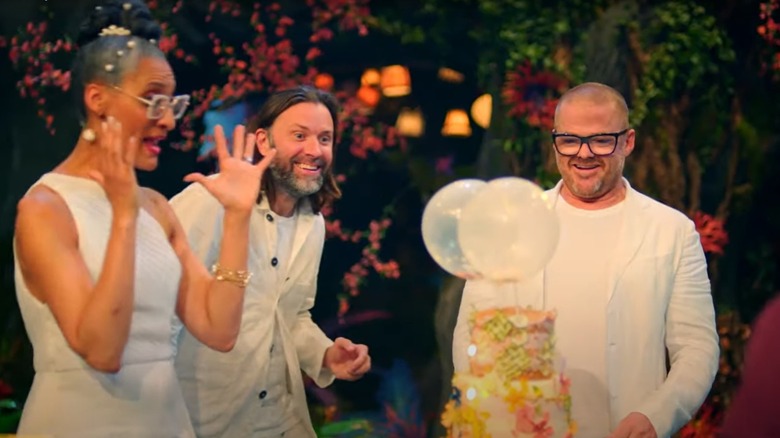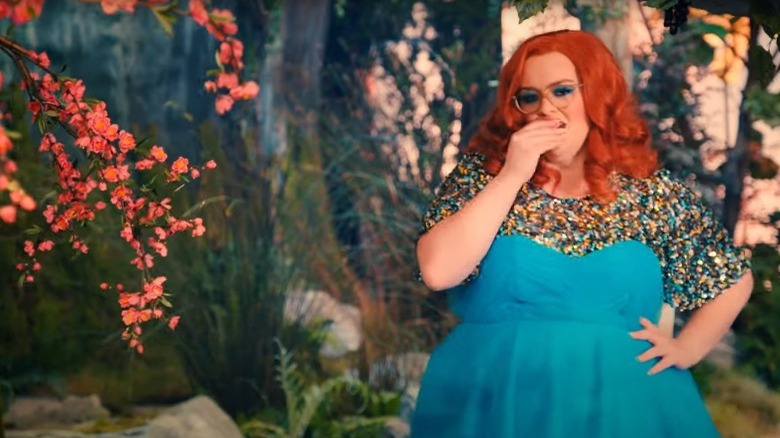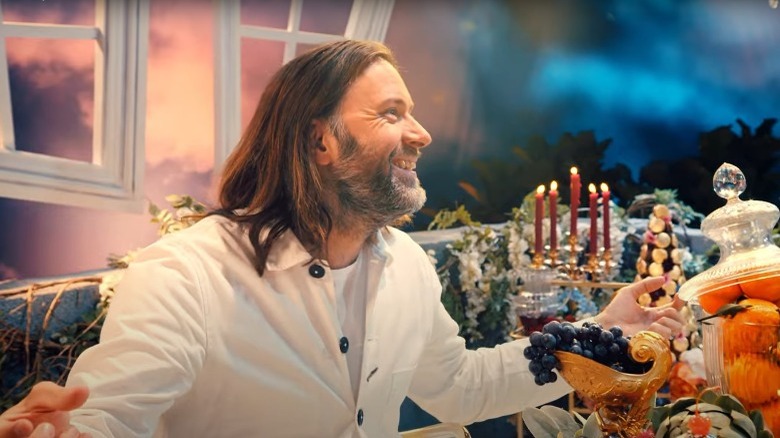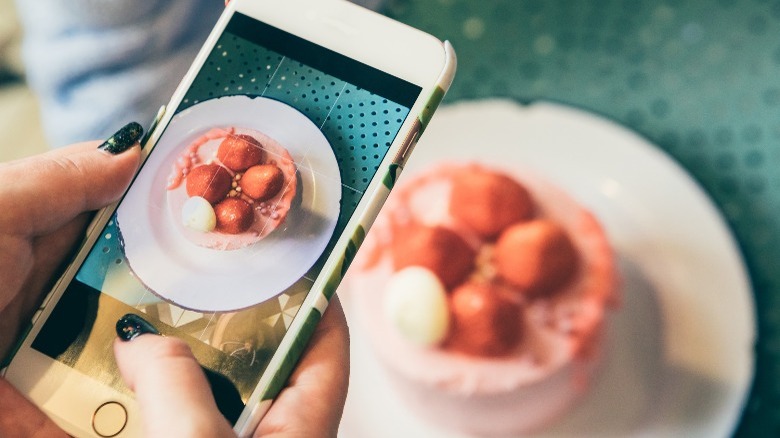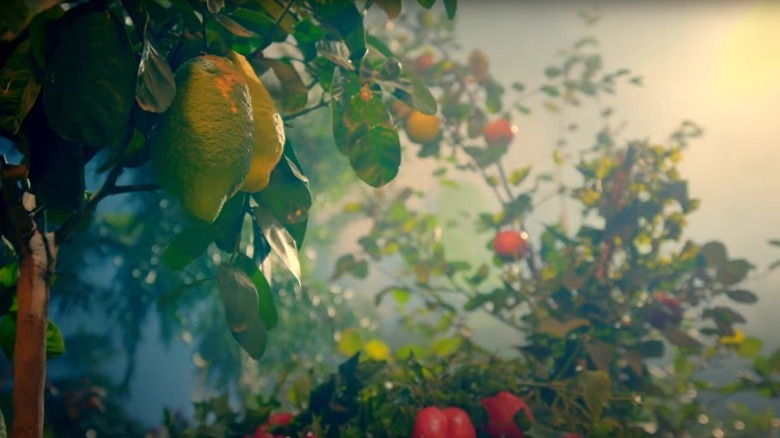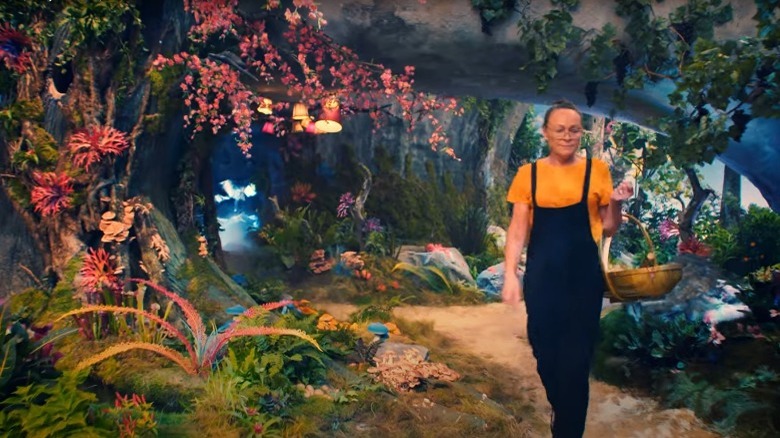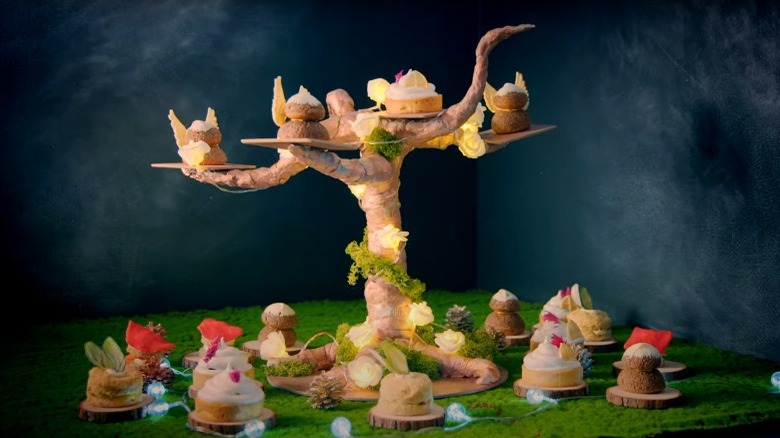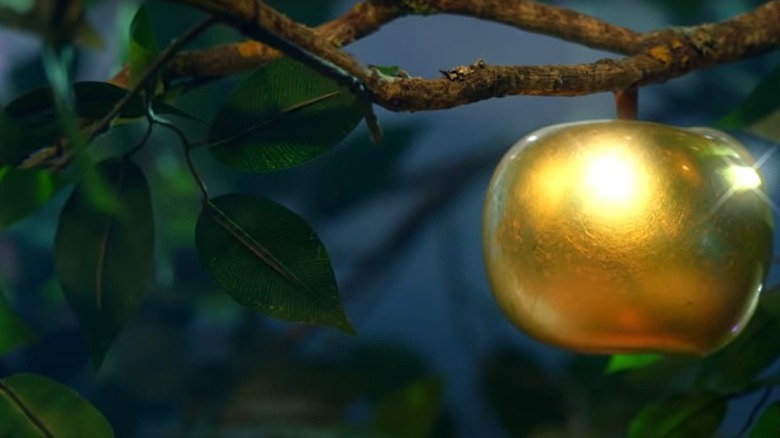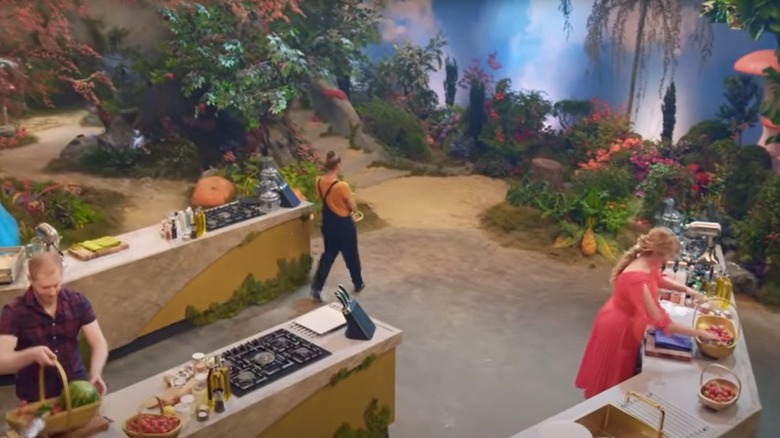The Untold Truth Of Crazy Delicious
In "Crazy Delicious," the contestants, who are not trained chefs but foodies with a knack for turning everyday food into art, have to hand-pick their own mushrooms and uproot their own carrots before firing up the stove. There's no other food reality show where we see contestants ambling around a garden foraging for produce. Their dishes have to be equal part crazy and delicious — a task which British chef Heston Blumenthal, a judge on the show, himself agrees is a toughie. "I've spent my career trying to perfect these kinds of dishes (that are visually striking and delicious) and I know from experience that creativity and perfection do not always sit comfortably together," he told Channel 4.
The show, which was released on Channel 4 and Netflix in January 2020, introduced viewers to the world's first edible set. It's "like Willy Wonka meets A Midsummers Night's Dream," according to the host of the show, British comedian Jayde Adams (via Grazia), or like "a Tim Burton Movie," per chef Carla Hall, a judge on the show (via The Hollywood Reporter). But where did the team get the inspiration to turn an indoor studio into a full-blown garden? How did they maintain it? More importantly, how crazy can the dishes get? Here are all the things that make "Crazy Delicious" a crazy watch.
The show first premiered in the UK
Though "Crazy Delicious" premiered on Channel 4, a British public network, and Netflix, an American streaming service, just a few days apart (on Channel 4 first, per Delish), the show seems to have been intended for a British audience, per a news release published on the Channel 4 website. The show that has contestants turning everyday ingredients into aesthetic toothsome creations hoped to inspire British families who reportedly are content with a lack of variety in their meals.
A survey published by the Independent showed that six in 10 Britons didn't mind copy-pasting their last week's meal plan for the following week, and the week after. Why? Either they were too set in their ways or too busy to innovate; some were just outright fussy with their food while others didn't see any sense in straying from what they already knew they liked, per the survey. However, seven in 10 also felt that they needed to spruce up their diet; and almost the same number were also ignorant about whether their meals provided them with the right amount of nutrients. While the show wouldn't delve into the nutritional value of each dish, what it could give is a shot of inspiration to make rainbow-colored falafels or switch the ordinary vanilla ice cream for one made with carrots (via IMDb).
The judges and the host are seen in the same costumes throughout
The set, with its chocolate soil and edible blossoms (via Eater), might be enticing, but not enough to have fans overlook a rather strange thing about the show — the fact that all its judges and the host are dressed the same in all six episodes. While the three judges — British chef Heston Blumenthal, American chef Carla Hall, and Swedish chef Niklas Ekstedt — are seen in eye-blindingly white clothes, the host, British comedian Jayde Adams, wears a sequin-studded turquoise dress. Some watchers of the show took to Reddit to share the observation, "Anyone find it odd they wear the same outfits the whole season?" Yet another Redditor specifically pondered the show's decision to have the host Adams wear the same dress throughout.
In fact, there was so much uproar over Adams' strictly consistent look throughout the six episodes that she took to Twitter to acknowledge the buzz: "I'm loving how livid the Crazy Delicious fans are about me wearing one outfit for the whole series. Let's just say, this is definitely gonna help me get more if we get a next time." To this, a fan responded, "You HAVE to get a next time — it's great! And we want a new outfit every scene!" It didn't matter that the show was essentially about innovative food; the team's wardrobe choices got a share of the limelight too.
Some viewers didn't like the judges being shown as food gods
Ultimately, "Crazy Delicious" is a cooking competition where contestants are judged for their creativity and skills in the kitchen. The show seems to have weaved a biblical theme around the judgment by calling the judges "food gods" and having them sit on a raised platform amongst fake fluffy clouds dressed in all white. The contestants have to climb a few steps to reach the "gods," place their plates before them, and wait for, well, the judgment. The theatricals are no doubt creative, but they rubbed some people the wrong way (via Daily Mail). Someone who watched the show took to Twitter to vent, "Heston is a very good cook — but he is not a god and it's offensive." Another Twitter user added, "I like the Alice in Wonderland/ Charlie and the Chocolate Factory vibe of #Crazy Delicious but calling the judges 'Gods' is a step too far for me." Yet another had it out with a straightforward, "stop calling them Gods!!!!"
Gods or not, they are well-known celebrity chefs — British chef Heston Blumenthal runs a three-Michelin star restaurant The Fat Duck, which was called "the best restaurant in the world" by Restaurant Magazine in 2005 (via 50 Best). Carla Hall was the host of the Emmy Award-winning food talk show "The Chew." Per the BBC, popular Swedish chef Niklas Ekstedt is the owner of a Michelin-starred restaurant.
The series was inspired by food posts on Instagram
No matter how much Heston Blumenthal hates people taking photos of food, photos of lip-smacking eats on social media are here to stay. These artistic clicks of fine-looking meals are, in fact, what inspired the idea for "Crazy Delicious." According to the executive producer of "Crazy Delicious," Nicola Pointer, "The inspiration for the series came from the world of #foodporn and home cooks posting incredible dishes on Instagram" (via Broadcast). All the 18 contestants featured in the six episodes of the show (three competing per episode) have their Instagram grids up to date with photos of their gourmet creations. Social media, without a doubt, played a key role in them landing a spot on the edible sets of the show. In fact, one of the contestants, Hanelore Dumitrache, wrote in her blog that she was contacted by the show six months into starting her Instagram page SugarYums, which features a curated collection of her mouth-watering recipes.
Pointer said, "This (the posts on Instagram) provided a great starting point for the team, but it would take several schedule-busting rounds of auditions to flush out the characters who could cook well under pressure." Dumitrache landed an audition after making it through two calls. For the final two rounds, she had to take along a dish (she took a Harry Potter-themed pie), and whip up a brunch dish in 15 minutes to impress the selection panel.
The set has 117 varieties of fresh produce
An 11,000-square-foot studio space was converted into an edible garden with over 100 varieties of produce including pumpkins, a galangal plant, and a Szechuan pepper tree for the show (via Daily Mail). Designing a space that brims with real plants was, as the production team of the show learned, a big challenge. "Growers were enlisted to plant fruit and vegetables in troughs that could be transported to the studio, but we soon learned you can't just order ingredients to be ripe for picking and camera-ready on demand," executive producer Nicola Pointer told Broadcast.
The team also learned that you can't fly in plants from somewhere and simply replant them in the studio: "leaves fall, roots die, tops wilt and they simply won't perform," Pointer said. To get those apples looking perfectly ripe, for example, they had to get a plant that was just about to fruit and cold-store it until the shoots grew before using them in the studio. "I had no idea what ducking and diving it would take to fill our garden with the fresh produce needed, but somehow, we ended up with 117 varieties for the cooks to use," Pointer added. As for other items such as seafood, meat, poultry, flour, and pasta, the set does have fridges and pantries, per Eater.
Not everything in the set is edible
While in the show's teasers, the host Jayde Adams is seen walking past a champagne brook, plucking a real banana off a tree, and eating a spoonful of what looks like mud (it's chocolate soil), there are some parts of the garden that cannot be gobbled up. For example, the rocks were made of fiberglass, some tree trunks were, in fact, tree trunks, and the gravel was just what you thought it was: gravel. The show's garden art director, Adam Game, wanted to keep the garden as real as possible, which meant no artificial grass. With this also came the challenge of maintaining its fresh look through the week. "No natural light and daily extremes in temperature made for a very hostile environment for the plants, meaning many needed to be regularly replaced," said Game (via Broadcast).
The show's production went on for four weeks, during which they had to make it seem as if the flowers remained in full bloom and the grass maintained its sheen. Daily watering could only do so much. They had to use golf course paint on the grass, and when that wasn't enough, they kept replacing the moss and turf (over 350 crates of moss and 400 rolls of turf were used) between episodes, added Game. As for the flowers, they were fake. The show was shot during the fall, and there was just no way they could have kept them in bloom, Game said.
Contestants have to come up with crazy twists to everyday dishes
A corn dog made with pig's blood cake, monkey-faced rice balls, and a pizza volcano (a reimagined pizza made with charcoal dough balls) were just some of the dishes that were presented to the judges in "Crazy Delicious." The show introduced viewers to burgers made with squid ink and stuffed carrots that looked like tree logs (via Alpha Foodie). One of the contestants had the clever idea of barbecuing an entire watermelon to look like a steak. "Another did something that looked like a burger, but it was deep-fried ice cream," Chef Heston Blumenthal, one of the judges on the show told The Herald. "There was a wide range of creative craziness! Some were delicious, some made no sense," he added.
The whole point of the show was to make the viewers see their everyday food differently. Like Blumenthal said, "One of the things I'd love to see with this series is people thinking, 'If they can have a go, why can't I have a go?'" He added, "Many people today are scared of failing — and that gets in the way of creativity." Translation: don't hesitate to turn your carrots into spiced ice cream, or tomatoes into a Bloody Mary macaron.
The winner gets zero cash prize
The contestants in "Crazy Delicious" slog for four hours to create awe-inspiring dishes that may or may not win them a golden apple (via Eater). A shiny apple is the only tangible award that the winner takes home. And though it's plucked off of a tree in the garden, it's a trophy, much like the cake stand that winners of the "The Great British Bake Off" get. British food shows, per Newsweek, aren't generous with cash prizes — "British Bake Off", "The Taste," and "MasterChef UK," all award the winners zero money. In comparison, the MasterChef US winner takes home a whopping $250,000, and the Top Chef winner also bags a $250,000 cash prize.
Newsweek reports that the British shows, specifically the BBC ones, don't shower an awful lot of cash on show winners as it is a publicly funded network and can't afford to pay large prizes with the taxpayers' money. However, what they can afford to do is turn the winners into television celebrities, or as 2014 "Bake Off" contestant Martha Collison told The Sun, "become a national treasure." Collison is right. Nadia Hussain, the winner of 2015 "Bake Off," took no cash prize but went on to publish cookbooks, pen columns in The Times Magazine, have her own television shows, and bake a cake for Queen Elizabeth's 90th birthday (via Insider).
The show has an exhausting filming schedule
To shoot the entire season one of the show in four weeks (via Broadcast), the entire crew seems to have kept up with a tight schedule. "Filming was extremely intense and exhausting," a contestant on the show, Hanelore Dumitrache, wrote in her blog SugarYums. Every day, the shooting for the show started at 7 am and went on till 10 pm. Per the blog, she had two half-hour breaks for lunch and breakfast and had to get up as early as 5 am for makeup and hair. "Although the set was absolutely gorgeous and it felt like the Garden of Eden, being inside a studio with no windows, no phones or watches meant that I'd feel quite disoriented towards the end of the day, losing all concept of time and space," she said.
During the shoot, there were as many as 20 cameras surrounding the contestants, per Dumitrache. Though shot within a studio space, executive producer Nicola Pointer told Broadcast that she didn't want it to "look like a studio show". Instead, she opted for a "high-end, filmic look that would do justice to the food and the set," she added. For this, they had to swap the traditional studio set-up and go for more expensive cameras and lenses. For the contestants though, the stress was to finish cooking the dishes in time. "It was really challenging, but I loved every moment of it," said Dumitrache.
